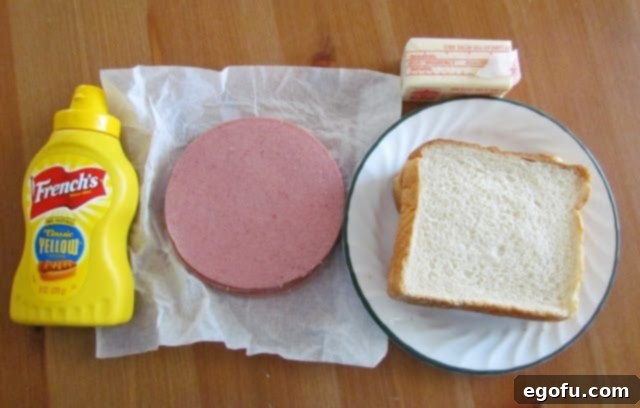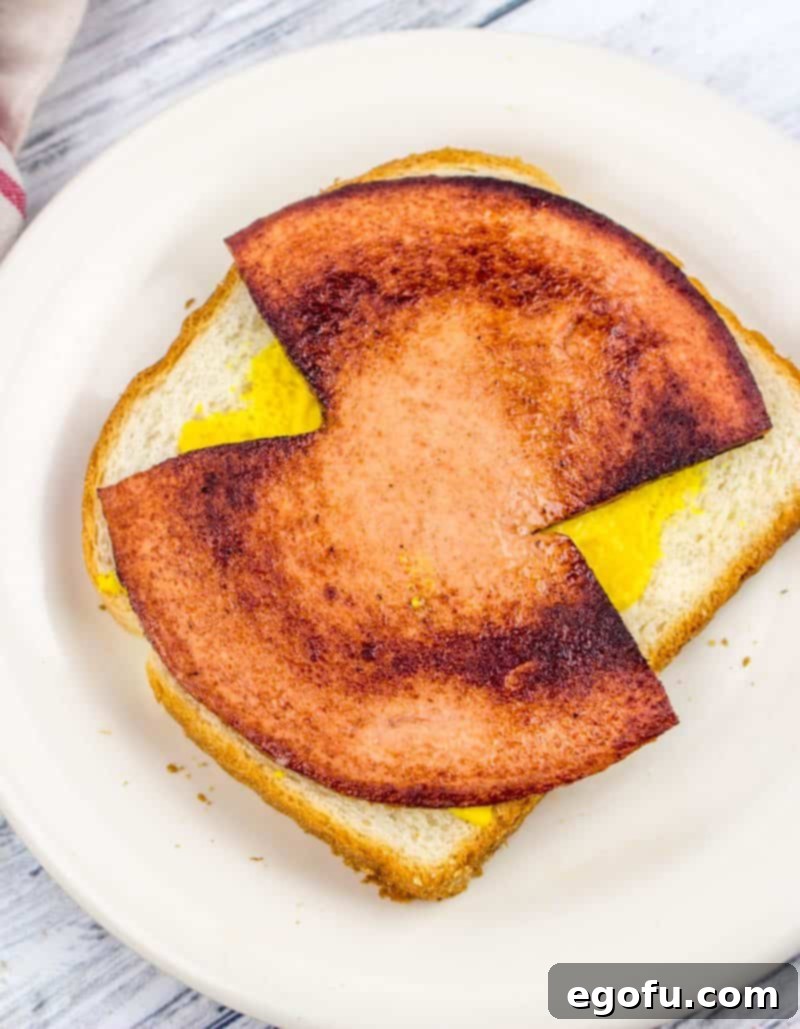The humble fried bologna sandwich holds a special place in the hearts of many, a nostalgic culinary beacon harking back to simpler times. It’s more than just a meal; it’s a memory, a taste of childhood, and a testament to the comforting power of unfussy ingredients. Featuring soft white bread, a generous spread of mustard, and perfectly crisp-fried bologna, this classic sandwich is an affordable, satisfying, and utterly delicious experience that transcends its modest origins.
Fried Bologna Sandwich: A Classic Comfort Food Recipe
A Timeless Taste of Home
Whether you call it “bologna” or “baloney,” the pronunciation debate fades into the background once you take that first bite of this iconic sandwich. For generations, the fried bologna sandwich has been a staple in American homes, particularly cherished for its ease of preparation and budget-friendly appeal. It’s the kind of meal that doesn’t require a special occasion or fancy ingredients – just good, honest flavor that satisfies the soul.
Many will attest that the “right way” to make a fried bologna sandwich is exactly how their mother or grandmother prepared it. This recipe aims to capture that authentic, cherished experience, offering a guide that respects tradition while allowing for personal touches. From the ideal crispness of the bologna to the choice of condiments, every element contributes to the unique character of this beloved dish. It’s a versatile canvas for comfort, proving that sometimes, the simplest pleasures are the most profound.

The Simple Art of Frying Bologna to Perfection
Achieving the perfect fried bologna isn’t complicated, but a few techniques can elevate your sandwich from good to unforgettable. The secret lies in a combination of proper preparation and attention to detail during frying. One of the most common questions revolves around why bologna tends to puff up into a bowl shape when cooked. This occurs because the edges cook and contract faster than the center. To counteract this and ensure your bologna lies flat, a simple cut is all that’s needed.
Many enthusiasts swear by cutting several small slits around the perimeter of the bologna slice, or even small triangles, which helps the meat relax and fry evenly. These small cuts not only prevent curling but also create extra crispy edges, adding a delightful texture contrast to the soft center. Experiment with different cutting methods to discover your preferred style – whether it’s uniform slits or creative shapes, each approach yields a slightly different textural experience that can make all the difference in your sandwich.
A Brief History of Bologna in America
Bologna, derived from the Italian mortadella from Bologna, Italy, made its way to America with European immigrants. However, the Americanized version became a distinct product, typically made from finely ground cured meats like pork, beef, or a mixture, seasoned and then smoked. It gained immense popularity in the early to mid-20th century as an economical and readily available protein source, especially during the Great Depression and World War II.
Its affordability and versatility made it a lunchbox staple and a go-to for quick family meals. The fried bologna sandwich emerged as a natural evolution of this trend, transforming a simple cold cut into a warm, savory, and more substantial meal. It speaks to a time when resourcefulness was key, and creating satisfying dishes from everyday ingredients was an art form. This enduring legacy is why the fried bologna sandwich remains a beloved symbol of American comfort food, connecting generations through its enduring appeal.

Ingredients for Your Perfect Fried Bologna Sandwich
Crafting the ultimate fried bologna sandwich requires just a handful of straightforward ingredients, each playing a crucial role in delivering that classic flavor and texture. Quality matters, even in simplicity, so choose your components wisely for the best possible outcome:
- Salted Butter (or Margarine): The foundation of flavor for frying. Butter creates those irresistibly crispy, golden-brown edges on the bologna and adds a rich, savory depth that oil alone can’t quite match. If you prefer, margarine can also be used for a similar effect.
- Thickly Sliced Bologna: This is the star of the show. While standard deli slices work, a thicker cut of bologna (around 1/4 to 1/2 inch) is highly recommended. Thicker slices stand up better to frying, maintaining a tender interior while developing a satisfyingly crisp exterior.
- Soft White Bread: Tradition dictates soft white bread, and for good reason. Its gentle texture perfectly complements the crisp bologna, absorbing the flavors and providing a comforting base. While you can toast it for an extra crunch, untoasted white bread is the classic choice.
- Yellow Mustard: The quintessential condiment for a fried bologna sandwich. Its tangy, slightly pungent flavor cuts through the richness of the bologna and butter, adding a necessary zing.
- Optional Condiments and Toppings: Feel free to customize your sandwich to your liking. Popular additions include:
- Mayonnaise for creaminess.
- Freshly sliced ripe tomatoes (especially when in season) for a burst of juicy freshness.
- A slice of American cheese (or your favorite cheese) for a gooey, melty layer.
- Crisp lettuce leaves for added crunch and coolness.
- Dill pickle slices for an extra tangy bite.
- Sliced onions for a sharp, savory kick.

How to Make the Ultimate Fried Bologna Sandwich
Creating this iconic sandwich is incredibly straightforward, promising a delicious result with minimal effort. Follow these steps to achieve fried bologna perfection:
- Prepare the Bologna: Lay your slices of bologna flat. To prevent them from puffing up into a bowl shape during frying, make two small triangle-shaped cuts (like Pac-Man) on opposite sides of each slice, or simply cut two small slits on each side. These cuts allow the bologna to expand evenly and ensure it cooks flat, creating more crispy surface area. If you’re feeling adventurous, you can fry these small cut-out pieces separately for an extra crunchy snack!
- Heat the Skillet: Place a skillet or frying pan over medium heat. Add about a tablespoon of salted butter. Allow the butter to melt and shimmer, indicating it’s ready for frying. Don’t be shy with the butter; it’s key to achieving those coveted golden-brown, crispy edges. If your pan seems dry during cooking, feel free to add a little more.
- Fry the Bologna: Once the butter is melted and sizzling, carefully place the bologna slices into the hot skillet. Fry for 2-4 minutes per side, or until the bologna reaches your desired level of crispness and color. Some prefer a lighter fry, where the bologna is just warmed through and slightly browned, while others, like my husband, prefer it deeply caramelized and crunchy. Flip the bologna at least once to ensure even cooking. If you cut out small shapes, toss them in the pan too – they become deliciously crispy!
- Prepare the Bread: While the bologna is frying, prepare your bread. You can use soft white bread straight from the package for that traditional feel, or for an added layer of texture, lightly toast your bread in a separate toaster or by briefly placing it in the skillet after removing the bologna.
- Assemble Your Sandwich: Once the bologna is fried to your liking, remove it from the skillet and place it on one slice of your chosen bread. Spread a generous amount of yellow mustard on the other slice – or mayonnaise, if that’s your preference. If using cheese, place it on the hot bologna immediately so it begins to melt slightly. Add any other desired toppings like sliced tomatoes, lettuce, or pickles.
- Serve Immediately: Place the second slice of bread on top, pressing down gently. If your bologna did curl slightly, don’t worry, the top slice of bread will help flatten it out. Slice the sandwich in half diagonally for easy eating, and serve while warm for the best experience.

Tips for the Ultimate Fried Bologna Sandwich
- Don’t Skimp on the Butter: Butter is essential for flavor and that beautiful crispy crust. If you’re hesitant about the amount, remember it contributes significantly to the sandwich’s nostalgic taste and texture.
- Customizing the Crispness: The cooking time directly impacts the bologna’s crispness. For a softer, slightly warmed bologna, fry for less time. For maximum crispiness, let it cook until the edges are dark brown and slightly crunchy. Don’t be afraid to experiment to find your ideal texture.
- The “Pac-Man” Cut is Key: Making those little triangle cuts or slits prevents the bologna from curling up. This ensures even cooking and allows the entire surface to get perfectly golden and crisp, rather than just the edges.
- To Toast or Not to Toast: While traditionally served on untoasted soft white bread, toasting your bread adds an extra layer of crunch and warmth. It’s a matter of personal preference, so feel free to try both ways!
- Condiment Considerations: Yellow mustard is classic, but don’t limit yourself. Mayonnaise adds a creamy richness, while a blend of mayo and mustard offers a balanced flavor. Hot sauce or a dollop of relish can also provide an interesting twist.
- Seasonal Toppings: If fresh, ripe tomatoes are in season, a thick slice elevates the sandwich with a burst of juicy, sweet-tart flavor. The slight bowl shape the bologna might take on can even serve as a convenient holder for a tomato slice!

Creative Variations and Toppings
While the classic fried bologna sandwich is perfect in its simplicity, it also serves as an excellent base for experimentation. Here are some ideas to customize your sandwich:
- Cheese Please: A slice of American, cheddar, or provolone cheese melted on top of the hot bologna takes this sandwich to another level of indulgence.
- The Works: Combine crisp lettuce, fresh tomato slices, crunchy pickles, and a thin slice of onion for a loaded, deli-style experience.
- Spice It Up: Add a dash of hot sauce, a sprinkle of red pepper flakes, or a slice of jalapeño for those who crave a little heat.
- Breakfast Boost: Turn it into a hearty breakfast sandwich by adding a fried egg and a slice of cheese.
- Different Breads: While white bread is traditional, don’t hesitate to try sourdough, rye, potato bread, or even a toasted bun for a different texture and flavor profile.
- Gourmet Mustard: Explore different types of mustard, such as Dijon, whole grain, or honey mustard, for a more sophisticated flavor.

My husband prefers mayo only on his, highlighting that personal preference is truly paramount when it comes to this flexible meal.

If the bologna still forms a slight bowl shape, don’t worry. Simply press it down gently with the top piece of bread, and it will conform nicely. In fact, that little curl can sometimes make a convenient holder for a perfectly ripe slice of tomato!

A nice slice of tomato adds both color and a refreshing counterpoint to the rich, savory bologna.

Serving Suggestions and Pairing
The fried bologna sandwich pairs wonderfully with classic American sides. A bag of your favorite potato chips provides an ideal crunch and saltiness, while an ice-cold glass of Coca-Cola or sweet tea perfectly complements its savory richness. For a more complete meal, consider serving it alongside a simple green salad, a cup of tomato soup, or some crisp French fries. This humble sandwich, paired with these comforting sides, offers a delightful trip back to simpler, more relaxed days.

Frequently Asked Questions About Fried Bologna Sandwiches
What kind of bologna is best for frying?
For the best fried bologna sandwich, we highly recommend using thick-cut bologna. While regular deli-thin slices can be used, a thicker slice (around 1/4 to 1/2 inch) holds up better to frying, crisps up beautifully on the edges, and remains tender in the center, offering a more satisfying bite. Look for quality brands that offer a good balance of flavor and texture.
Why do I need to cut slits in the bologna?
Cutting small slits or triangles around the edge of the bologna slice prevents it from curling up into a bowl shape when it cooks. Bologna, like other cured meats, contracts as it heats. These cuts allow the meat to expand evenly, ensuring a flat, evenly cooked, and maximally crispy slice that’s easier to fit on your bread.
Can I use oil instead of butter for frying?
While you can use vegetable oil, canola oil, or even bacon grease, butter is traditionally preferred for frying bologna. Butter adds a rich, savory flavor and contributes significantly to the golden-brown crispness of the bologna edges that is characteristic of this classic sandwich. If you’re looking to replicate the nostalgic taste, butter is the way to go.
What are some non-traditional toppings I can add?
Beyond the classic mustard, feel free to get creative! Some popular additions include a fried egg, sautéed onions, pickled jalapeños for a kick, a slice of avocado, or even a drizzle of sriracha mayo. Different types of cheese like Swiss or provolone also work well for a varied flavor profile.
Is a fried bologna sandwich healthy?
The fried bologna sandwich is typically considered a comfort food rather than a health food. Bologna itself is a processed meat that can be high in sodium and fat. Frying it in butter and serving it on white bread with rich condiments further adds to its caloric and fat content. Enjoy it as an occasional treat, and balance it with healthier choices throughout your diet. For nutritional information, refer to the approximate values provided in the recipe card.
Can I make this sandwich ahead of time?
For the best taste and texture, a fried bologna sandwich is best enjoyed immediately after preparation. The bologna is at its crispiest, and the bread is perfectly soft or toasted. If made ahead, the bologna will lose its crispness, and the bread may become soggy. However, you can prep your ingredients, like slicing tomatoes, ahead of time to make assembly quicker.
Craving More Nostalgic Recipes?
If the fried bologna sandwich sparked a craving for more classic comfort food, explore these other beloved recipes that bring a taste of the good old days to your table:
- Old-Fashioned Bologna Salad
- Classic Tuna Melt
- Grilled Cheese Dippers
- Tuna Salad Sandwich
- Kmart Subs

Fried Bologna Sandwich Recipe
Fried Bologna, or Fried Baloney, is one of those old school sandwiches. Soft white bread, a schmear of mustard and crisp fried bologna!
Recipe Details
- Cook Time: 10 minutes
- Total Time: 10 minutes
- Servings: 4 sandwiches
- Author: Brandie Skibinski
Ingredients
- 1-2 Tablespoons salted butter
- 4 slices thick bologna
- 8 slices white bread
- Yellow mustard (to taste)
- Optional condiments: mayonnaise, sliced tomatoes, American cheese, pickles, lettuce
Instructions
- Cut a small triangle shape (like Pac-Man) on each side of the bologna slice, or make two small slits on each side (this is optional but helps prevent curling).
- Place a skillet over medium heat and add about a tablespoon of butter. If more butter is needed during cooking, add a bit more.
- Once the butter is melted and shimmering, place the bologna slices into the skillet.
- Fry the bologna until it reaches your desired color and crispness, flipping it over at least once. This usually takes 2-4 minutes per side.
- When finished, place the hot fried bologna between two slices of white bread. Spread one side of the bread with yellow mustard (or your preferred condiment).
- Serve immediately with your favorite sides.
Notes
- You can toast your bread for an extra crunch if desired.
- Customize your sandwich with any condiments and toppings you like, such as mayo, lettuce, tomato, or cheese.
Video
Nutrition (Estimate per serving)
- Calories: 244 kcal
- Carbohydrates: 26g
- Protein: 8g
- Fat: 11g
- Sodium: 539mg
- Fiber: 1g
- Sugar: 3g
Nutritional Disclaimer
The nutritional information provided is an estimate. As “The Country Cook” is not a dietician or nutritionist, we recommend running the ingredients through your preferred online nutritional calculator for precise values, as they can vary depending on the brands used.
Originally published: August 2012
Updated & republished: February 2020
